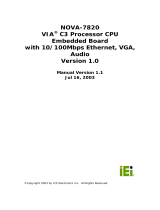
AR-B5230 Series User’s Manual
4/25
1
INTRODUCTION
Welcome to the AR-B5230 Series (5230/5231) EPIC board. The AR-B5230 Series (5230/5231)
incorporates the advanced Intel
®
915GME(5230)/910GMLE(5231) Chipset. It supports the
Pentium M and Celeron M processors, while coming with a 400MHz Front Side Bus.
1.1 Specifications
CPU: Socket for Intel uFC-PGA 478 for Pentium M, Celeron M, Coolers required
Support CPU type:
CM-0.6G/400/512K/BGA(AR-B5231)
CM-1.0G/400/0K/BGA(AR-B5231)
CM-1.3G/400/512K/PGA(320)
CM-1.5G/400/1M/PGA(370)
PM-1.6G/400/1M/PGA
PM-2.0G/533/2M/PGA(760)
PM-1.8G/400/2M/PGA(745)
BIOS: AWARD
System Chipset: Intel 915GME(5230)/910GMLE(5231) + ICH6M
Syetem Memory: One SO-DIMM socket support 400/533MHz(5230) 400MHz(5231) DDR2
SDRAM up to 1GB
Graphic controller: Internal Intel 82915GME(5230)/82910GMLE(5231) integrated GMA 900
graphic controller
VGA Memory: Intel DVMT 3.0 supports Max 128 MB shared video memory
Display mode:
CRT (always on)
DVII
LCD : Dual Channel 18-bits LVDS Interface
Audio: AC’97 Audio out/Audio in/Mic in
Ethernet:
Intel 82562EZ 10/100Mbps LAN PHY
Intel 82541PI Giga LAN controller
Storage:
One PATA
One SATA
One CF: Compact Flash Type-II support UDMA
Serial port:
One RS232 (COM1)
One RS232/422/485 (COM2)
Two RS232 (COM3, COM4)
USB:
Two external ports
Two internal ports




























